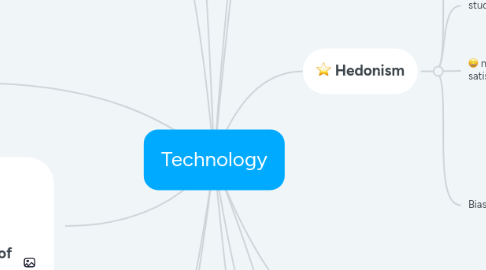
1. Behavior
1.1. Affective
1.2. Cognitive
1.2.1. emotional response
1.3. Conative
2. Engineer’s Psychology of Technology
2.1. opaque
2.2. unnatural skills of the user
3. Cognition
3.1. Emotion
4. Pleasure
4.1. physical
4.2. social
4.3. psychological
4.4. reflective
4.5. normative
5. Humanists’ Psychology of Technology
5.1. transparent
5.2. natural skills
6. Artificial Intelligence
6.1. human becoming
6.2. robots
6.3. machine
6.3.1. innovations
6.3.1.1. ease works
6.4. other human like machines
7. Where's the user?
7.1. Man-machine
7.2. Human Computer
7.3. User-centered
8. Economics
8.1. of pleasure
9. Hedonism
9.1. features artifacts
9.1.1. Designing
9.1.1.1. Engineering
9.1.1.1.1. Kansei/Kanzei
9.1.1.1.2. Citarasa
9.1.1.2. Personality Aspects
9.1.1.2.1. Unpleasant
9.1.1.2.2. Pleasant
9.2. study of pleasure
9.3. maximize how happiness will bring more satisfaction
9.3.1. not just by merely accumulating it.
9.3.2. Its Basic Postulate: pleasure and usability should go hand in hand and that satisfaction with the product is maximal
9.4. Biases:
9.4.1. Cognitive
9.4.1.1. mind/perceptions
9.4.2. Self-serving
9.4.2.1. protecting oneself
9.4.3. Situational
9.4.3.1. Situational blame
9.4.4. Dispositional
9.4.4.1. Individual blame
9.4.5. Projection
9.4.5.1. projecting to another
10. Ergonomics
10.1. DESIGNS
10.1.1. safety
10.1.2. productivity
10.1.2.1. Levels
10.1.2.1.1. Behavioral
10.1.2.1.2. Reflective
10.1.2.1.3. Visceral
10.1.3. operator's satisfaction
10.2. Affective
10.2.1. Engineering Aesthetics
10.2.1.1. Consumer Loyalty
10.2.1.1.1. Emotional Penalties
11. Time Perception
11.1. gives
11.1.1. joy
11.1.2. interest
11.1.3. love
11.1.4. contentment
11.1.5. pride
12. Internet of Things
12.1. interconnectedness
12.2. technology reach
12.2.1. communication
12.2.1.1. peers
12.2.1.2. lovers
12.2.1.3. workmates
12.2.1.4. family
12.3. ease the works
13. Intervention
13.1. assists
13.1.1. clients
13.2. teaching machine
13.2.1. applications
13.3. Technological
13.3.1. gadgets
13.3.1.1. for day-to-day activities
